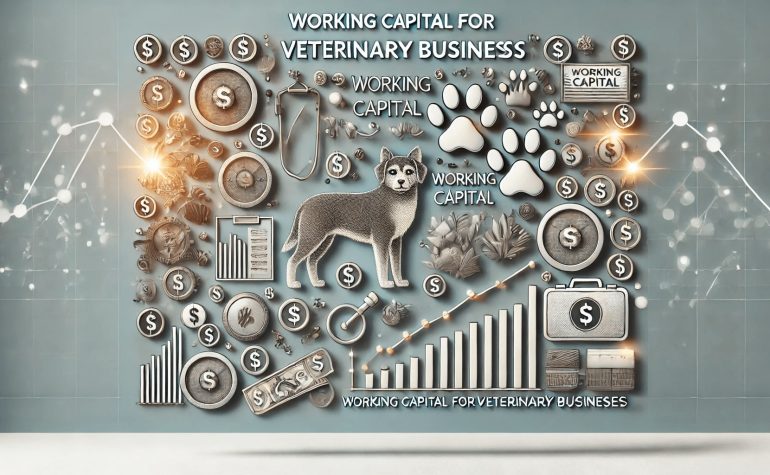
By alphacardprocess October 5, 2024
Working capital is a crucial aspect of any business, including veterinary practices. It refers to the funds available to a company for its day-to-day operations and is a measure of its liquidity, efficiency, and overall financial health. In the context of veterinary businesses, working capital plays a vital role in ensuring smooth operations, providing quality care to animals, and maintaining a sustainable practice.
Understanding the Importance of Working Capital in Veterinary Practices
Working capital is essential for veterinary practices as it enables them to cover their short-term expenses, such as payroll, inventory, and supplies. It ensures that the practice can continue to operate efficiently without disruptions, even during periods of low revenue or unexpected expenses. Without sufficient working capital, a veterinary practice may struggle to meet its financial obligations, resulting in a decline in the quality of care provided to animals and potential damage to its reputation.
Calculating Working Capital: Key Metrics and Formulas

To calculate working capital, several key metrics and formulas are used. The most common formula is:
Working Capital = Current Assets – Current Liabilities
Current assets include cash, accounts receivable, and inventory, while current liabilities encompass accounts payable, accrued expenses, and short-term debt. By subtracting current liabilities from current assets, the working capital of a veterinary practice can be determined.
Another important metric related to working capital is the current ratio, which is calculated by dividing current assets by current liabilities. This ratio provides insights into the liquidity of a veterinary practice and its ability to meet short-term obligations. A current ratio of 2 or higher is generally considered healthy, indicating that the practice has sufficient working capital to cover its liabilities.
Factors Affecting Working Capital in Veterinary Businesses
Several factors can impact the working capital of veterinary businesses. These include:
- Seasonality: Veterinary practices often experience fluctuations in revenue due to seasonal variations in demand. For example, there may be a higher demand for services during the summer months when pet owners are more likely to travel or engage in outdoor activities with their pets. These seasonal variations can affect the working capital requirements of a veterinary practice.
- Growth and Expansion: As veterinary practices grow and expand, their working capital needs may increase. This is because larger practices typically have higher expenses, such as additional staff, equipment, and inventory. It is important for veterinary businesses to carefully manage their working capital to support growth while maintaining financial stability.
- Payment Terms: The payment terms offered to clients can impact the working capital of a veterinary practice. If the practice offers extended payment terms or has a high percentage of clients who delay payment, it can put a strain on its working capital. Implementing effective accounts receivable management strategies can help mitigate this risk.
- Inventory Management: Efficient inventory management is crucial for veterinary practices to optimize their working capital. Overstocking can tie up funds unnecessarily, while understocking can lead to lost revenue and dissatisfied clients. By implementing inventory control systems and analyzing demand patterns, veterinary businesses can strike a balance and ensure optimal working capital utilization.
Strategies for Managing and Optimizing Working Capital

To effectively manage and optimize working capital, veterinary businesses can employ various strategies:
- Cash Flow Forecasting: Developing a cash flow forecast can help veterinary practices anticipate their future cash inflows and outflows. By accurately predicting cash flow, practices can proactively manage their working capital and make informed decisions regarding expenses, investments, and financing.
- Efficient Accounts Receivable Management: Implementing effective accounts receivable management practices can help veterinary practices improve their cash flow and working capital. This includes setting clear payment terms, sending timely invoices, following up on overdue payments, and offering incentives for early payment.
- Streamlining Inventory Management: Adopting inventory management systems and processes can help veterinary practices optimize their inventory levels and reduce carrying costs. By analyzing demand patterns, monitoring expiration dates, and negotiating favorable terms with suppliers, practices can minimize inventory-related working capital requirements.
- Negotiating Payment Terms with Suppliers: Veterinary practices can negotiate favorable payment terms with their suppliers to improve their working capital position. This may include extending payment terms or negotiating discounts for early payment. Building strong relationships with suppliers can also lead to better pricing and terms.
The Role of Cash Flow Management in Veterinary Practices

Cash flow management is closely linked to working capital management and plays a crucial role in the financial health of veterinary practices. Effective cash flow management involves monitoring and controlling the inflow and outflow of cash to ensure that the practice has sufficient funds to meet its financial obligations.
By actively managing cash flow, veterinary practices can:
- Ensure Sufficient Liquidity: Maintaining sufficient cash reserves allows veterinary practices to cover their day-to-day expenses, such as payroll, rent, and supplies. It also provides a buffer for unexpected expenses or revenue fluctuations.
- Plan for Growth and Expansion: Effective cash flow management enables veterinary practices to plan for growth and expansion by ensuring that they have the necessary funds to invest in new equipment, hire additional staff, or open new locations.
- Reduce Financing Costs: By optimizing cash flow, veterinary practices can reduce their reliance on external financing, such as loans or lines of credit. This can help minimize interest expenses and improve overall profitability.
- Seize Opportunities: Having a strong cash flow position allows veterinary practices to take advantage of opportunities that may arise, such as acquiring a competitor, investing in new technology, or expanding service offerings.
Financing Options for Veterinary Businesses to Support Working Capital
In some cases, veterinary businesses may require additional financing to support their working capital needs. Several financing options are available to veterinary practices, including:
- Business Loans: Traditional business loans from banks or financial institutions can provide veterinary practices with the necessary funds to support their working capital requirements. These loans typically have fixed repayment terms and interest rates.
- Lines of Credit: Lines of credit are flexible financing options that allow veterinary practices to access funds as needed. They provide a revolving credit facility, allowing businesses to borrow and repay funds multiple times within a specified limit.
- Equipment Financing: Veterinary practices often require specialized equipment, such as X-ray machines or surgical instruments. Equipment financing allows practices to acquire the necessary equipment while spreading the cost over time.
- Invoice Financing: Invoice financing, also known as accounts receivable financing, allows veterinary practices to access funds by selling their outstanding invoices to a financing company. This provides immediate cash flow while waiting for clients to make payment.
Common Challenges and Solutions in Working Capital Management
Working capital management can present several challenges for veterinary businesses. Some common challenges include:
- Seasonal Variations: Seasonal variations in demand can impact the working capital requirements of veterinary practices. To address this challenge, practices can implement proactive cash flow forecasting, adjust staffing levels accordingly, and negotiate flexible payment terms with suppliers.
- Slow-Paying Clients: Clients who delay payment can strain the working capital of veterinary practices. To mitigate this risk, practices can implement stricter credit policies, offer incentives for early payment, and actively follow up on overdue invoices.
- Inefficient Inventory Management: Inefficient inventory management can tie up working capital and lead to increased carrying costs. By implementing inventory control systems, analyzing demand patterns, and negotiating favorable terms with suppliers, veterinary practices can optimize their inventory levels.
- Lack of Financial Visibility: Limited financial visibility can make it challenging for veterinary practices to effectively manage their working capital. Implementing robust financial reporting systems and regularly reviewing key performance indicators can provide practices with the necessary insights to make informed decisions.
Frequently Asked Questions
Q.1: What is working capital?
Working capital refers to the funds available to a company for its day-to-day operations. It is calculated by subtracting current liabilities from current assets and is a measure of a company’s liquidity and financial health.
Q.2: Why is working capital important for veterinary businesses?
Working capital is crucial for veterinary businesses as it enables them to cover their short-term expenses and ensures smooth operations. It allows practices to provide quality care to animals and maintain financial stability.
Q.4: How can veterinary practices calculate their working capital?
Veterinary practices can calculate their working capital by subtracting current liabilities from current assets. Current assets include cash, accounts receivable, and inventory, while current liabilities encompass accounts payable, accrued expenses, and short-term debt.
Q.5: What are some strategies for managing and optimizing working capital in veterinary practices?
Some strategies for managing and optimizing working capital in veterinary practices include cash flow forecasting, efficient accounts receivable management, streamlining inventory management, and negotiating payment terms with suppliers.
Q.6: What financing options are available to veterinary businesses to support their working capital needs?
Veterinary businesses can access financing options such as business loans, lines of credit, equipment financing, and invoice financing to support their working capital needs.
Conclusion
Working capital is a critical aspect of veterinary businesses, ensuring their financial stability and ability to provide quality care to animals. By understanding the importance of working capital, calculating key metrics, and implementing effective strategies for managing and optimizing working capital, veterinary practices can enhance their financial health and operational efficiency.
Additionally, by actively managing cash flow and exploring financing options when necessary, veterinary businesses can ensure they have the necessary funds to support their working capital requirements. With careful attention to working capital management, veterinary practices can thrive and continue to provide excellent care to their furry patients.